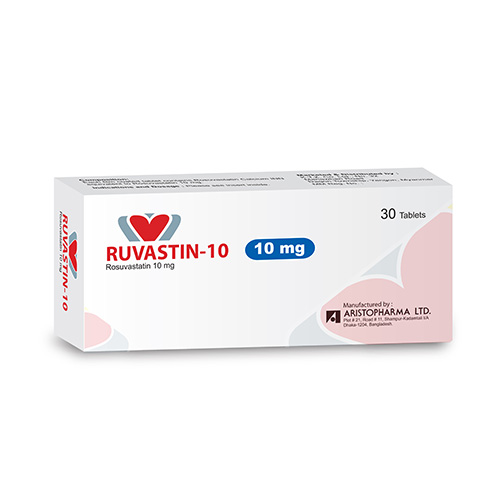
RUVASTIN – 10 Tablet
Therapeutic Class
Dyslipidaemic Agents
Indications
Ruvastin (Rosuvastatin) is an HMG Co-A reductase inhibitor indicated for: Adult patients with primary hyperlipidemia and mixed dyslipidemia as an adjunct to diet to reduce elevated total-C, LDL-C, ApoB, nonHDL-C, and TG levels and to increase HDL-C. Pediatric patients 8 to 17 years of age with heterozygous familial hypercholesterolemia (HeFH) to reduce elevated total-C, LDL-C and ApoB after failing an adequate trial of diet therapy. Pediatric patients 7 to 17 years of age with homozygous familial hypercholesterolemia (HoFH) to reduce LDL-C, total-C, nonHDL-C, and ApoB as an adjunct to diet, either alone or with other lipid-lowering treatments. Adult patients with hypertriglyceridemia as an adjunct to diet. Adult patients with primary dysbetalipoproteinemia (Type III hyperlipoproteinemia) as an adjunct to diet. Adult patients with homozygous familial hypercholesterolemia (HoFH) to reduce LDL-C, total-C, and ApoB. Slowing the progression of atherosclerosis as part of a treatment strategy to lower total-C and LDL-C as an adjunct to diet. Risk reduction of MI, stroke, and arterial revascularization procedures in patients without clinically evident CHD, but with multiple risk factors.
Chemical Composition
Rosuvastatin INN 10 mg
Packaging
Each box contains 30 tablets in Alu-Alu blister pack.
Dosage & Administration
General Dosing Information: The dose range for Ruvastin in adults is 5-40 mg once daily. The usual starting dose is 10 to 20 mg daily. Use 40 mg dose only for patients not reaching LDL-C goal with 20 mg. The usual starting dose in adult patients with homozygous familial hypercholesterolemia is 20 mg/day. Pediatric Dosing: In heterozygous familial hypercholesterolemia, the recommended dose range is 5 to 10 mg orally once daily in patients 8 to less than 10 years of age, and 5 to 20 mg orally once daily in patients 10 to 17 years of age. In homozygous familial hypercholesterolemia, the recommended dose is 20 mg orally once daily in patients 7 to 17 years of age. Dosing in Asian Patients: In Asian patients, consider initiation of rosuvastatin with 5 mg once daily dose due to increased rosuvastatin plasma concentrations.
Contraindications
Rosuvastatin is contraindicated in patients with known hypersensitivity (e.g. rash, pruritus, urticaria, and angioedema) to any component of this product. It is also contraindicated in patients with active liver disease, which may include unexplained persistent elevations of hepatic transaminase levels
Side Effects
Rosuvastatin is generally well tolerated. The following serious adverse reactions may occur: rhabdomyolysis with myoglobinuria and acute renal failure and myopathy (including myositis); liver enzyme abnormalities. The most common adverse reactions that led to treatment discontinuation are myalgia, abdominal pain, nausea, headache, asthenia, and nausea
Drug Interaction
Cyclosporine: Cyclosporine increase rosuvastatin’s exposure (AUC) to 7-fold. Therefore, in patients taking cyclosporine, the dose of rosuvastatin should not exceed 5 mg once daily. Gemfibrozil: Gemfibrozil significantly increased rosuvastatin exposure. If used together, the dose of rosuvastatin should not exceed 10 mg once daily. Protease Inhibitors: Coadministration of rosuvastatin with certain protease inhibitors has differing effects on rosuvastatin exposure. Caution should be exercised when rosuvastatin is co-administered with protease inhibitors (e.g. simeprevir, combinations of atazanavir/ritonavir, lopinavir/ritonavir, fosamprenavir/ritonavir etc). Coumarin Anticoagulatns: Rosuvastatin significantly increased INR (International normalized ratio) in patients receiving coumarin anticoagulants. Therefore, caution should be exercised when coumarin anticoagulants are given in conjunction with rosuvastatin. Niacin: The risk of skeletal muscle effects may be enhanced when rosuvastatin is used in combination with lipid- modifying doses (?1 g/day) of niacin; caution should be used when prescribing with rosuvastatin. Fenofibrate: Because it is known that the risk of myopathy during treatment with HMG-CoA reductase inhibitors is increased with concomitant use of fenofibrates, caution should be used when prescribing fenofibrates with rosuvastatin. Colchicine: Cases of myopathy, including rhabdomyolys, have been reported with HMG-CoA reductase inhibitors, including rosuvastatin, coadministered with colchicine, and caution should be exercised when prescribing rosuvastatin with colchicin.

